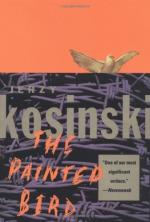|
This section contains 320 words (approx. 1 page at 400 words per page) |

|
The Painted Bird Summary & Study Guide Description
The Painted Bird Summary & Study Guide includes comprehensive information and analysis to help you understand the book. This study guide contains the following sections:
This detailed literature summary also contains Bibliography on The Painted Bird by Jerzy Kosiński.
Jerzy Kosinski's harrowing narrative, The Painted Bird, earned accolades from critics, yet also stirred a great deal of controversy when it was published in the United States in 1965. The novel, based on Kosinski's own experiences in Poland during World War II, centers on a young, unnamed boy's struggle to survive during the war by hiding in several remote villages in an Eastern European country. His parents had sent him to live with a foster mother while they hid from the Nazis, but when the foster mother dies, the boy is forced to wander alone from village to village. Due to his dark eyes and complexion, the villagers suspect he is a Jew or a gypsy and so continually torment him.
While some critics have found the novel's violence excessive, most applaud its realistic depiction of the horrors of World War II. Andrew Field in Book Week defends the novel, admitting:
So awful . . . is this book that I can scarcely 'recommend'
it to anyone, and yet, because there is enlightenment
to be gained from its flame-dark pages,
it deserves as wide a readership as possible.
Kosinski suffered years of torment after the novel's publication. The book was banned in Poland, his homeland, and he and his family suffered continual verbal and physical attacks by Eastern Europeans who considered the book slanderous to their culture. The novel endures, however, because of its powerful statement on the nature of cruelty and survival. In the Afterward of the second edition of The Painted Bird, Kosinski notes the impetus for the novel and for much of his writing: when his parents described their experiences during the war and their witnessing of "young children being herded into the trains," he writes, "it was therefore very much for their sakes and for people like them that I wanted to write fiction which would reflect, and perhaps exorcise the horrors that they had found so inexpressible."
Read more from the Study Guide
|
This section contains 320 words (approx. 1 page at 400 words per page) |

|



